How to protect your washing machine from leaks?
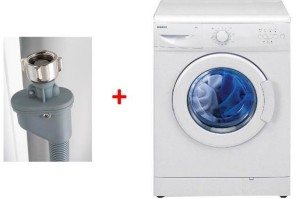 Finding a puddle of water under your washing machine is extremely unpleasant, because you will not only have to repair the machine, but also pay for repairs to the neighbors whom you flooded. However, in case of water leakage, there is special protection and an Aquastop system for the washing machine. It is worth considering the methods of such protection in more detail and understanding the disadvantages of each of them.
Finding a puddle of water under your washing machine is extremely unpleasant, because you will not only have to repair the machine, but also pay for repairs to the neighbors whom you flooded. However, in case of water leakage, there is special protection and an Aquastop system for the washing machine. It is worth considering the methods of such protection in more detail and understanding the disadvantages of each of them.
Protection options
All washing machines, depending on the presence of a protection system, can be divided into three groups:
- washing machines without protection;
- washing machines with partial protection;
- machines that are completely protected from leaks.
Most machines in the low and mid-price category are not equipped with leakage protection. What does this mean? And the fact that water is supplied to the machine from a water pipe through an ordinary flexible hose with special nuts at both ends. The bottom of such machines, as a rule, is missing or covered with a plastic panel. And if the inlet hose ruptures, then all the water in such a machine will flow out onto the floor. In a multi-storey building, a similar situation leads to flooding of the neighbors below.
Therefore, in this case It is recommended to close the water supply tap after turning off the machine or install an additional protection system yourself in the form of inlet hoses with valves, we will talk about them further. Some high-end washing machines already have protection installed. For example, complete protection against water leakage is available in washing machines under the following brands:
- Asko;
- Ariston;
- AEG
- Bosch;
- Siemins;
- Miele;
- Zanussi;
- Electrolux.
Partial protection against leaks
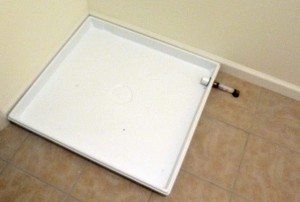 What is partial protection, let's figure out how it works.Machines with such protection against leaks are equipped with a special tray, for example, like the one in the figure.
What is partial protection, let's figure out how it works.Machines with such protection against leaks are equipped with a special tray, for example, like the one in the figure.
A float equipped with an electric switch is installed inside the pan. The tray is made of plastic or metal, the float is made of polystyrene foam. When water flows inside the machine, it falls into the pan, with a certain amount of water the float rises and the switch is activated. At its signal, the machine switches to emergency mode, the washing process stops, the pump operates and pumps out the water.
Important! In such a situation, an error code is displayed on the machine’s display; different models have different symbols, for example, code E1 will appear in an LG machine, and E9 in a Samsung machine.
If water leaks into the pan, you need to pour water out of it, and then look for the cause of the breakdown and fix it. You can learn about all possible causes and elimination of leaks from the article on why a washing machine leaks.
Inlet hoses with valves
Washing machines with partial protection are called so because the protection is activated only when water flows into the machine. But if the hose breaks in some place outside, then flooding cannot be avoided. In this case, it is worth considering inlet hoses equipped with protection. They come in three types:
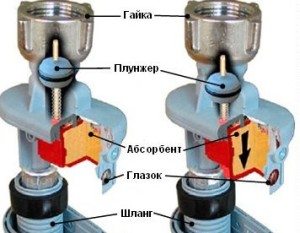 The first type of hose is a regular hose placed in a durable corrugated casing. At one end of the hose, connected to the water supply, there is a built-in protective block with a peephole. Inside the block there is a plunger held by a spring. When the hose ruptures, water gets inside, the spring weakens and the plunger closes the flow of water. After which the eye becomes red.
The first type of hose is a regular hose placed in a durable corrugated casing. At one end of the hose, connected to the water supply, there is a built-in protective block with a peephole. Inside the block there is a plunger held by a spring. When the hose ruptures, water gets inside, the spring weakens and the plunger closes the flow of water. After which the eye becomes red.Let's celebrate! The disadvantage of such a hose is that after activating the protection against water leakage, it will have to be completely replaced.
- The principle of operation of the second type of hose is generally no different from the first. The difference is that instead of a spring, inside the protective block there is a pair of magnets facing each other with the same poles. They are the ones who hold the plunger until water enters the protective block. This hose is also replaced after a leak.
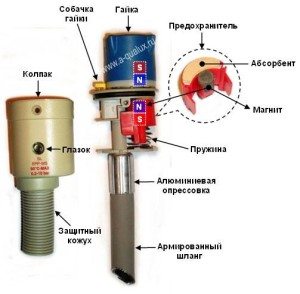
- The third type of hose does not have a mechanical valve, but an electromagnetic one. While the machine is disconnected from the network, the plunger shuts off the water supply; as soon as the machine is turned on, the valve opens. The control wires in such a hose are hidden under a durable sheath.
For your information! The Aqua Stop inlet hose is designed for a pressure of 70 bar, which is 7 times the maximum pressure in the pipeline.
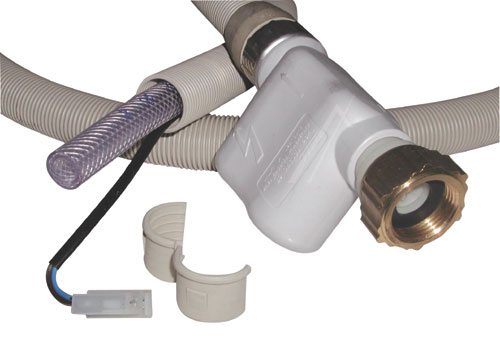
Complete protection against leaks - Aqua Stop system
Washing machines with complete protection against water leaks have not only a tray with a built-in float, but also a hose with a solenoid valve, which we described above. In other words, if you connect such a hose to a partially protected car, then it can be called fully protected.
Such protection against leaks is considered the most reliable. Undoubtedly, washing machines equipped with the Aqua Stop system have an advantage over conventional washing machines. By overpaying $20 for it, you won’t have to look for a high-quality inlet hose and figure out how to connect it correctly. The entire system has already been debugged by the manufacturer.
It should be noted that the “Aqua Stop” protection is triggered in cases of leakage of the washing machine tank, damage to the pipes, increased foaming and foam escaping.
In addition, complete protection against leaks is accompanied by an emergency water pumping system. It is triggered if for some reason the main and safety valves do not operate. The main valve is the machine valve to which the inlet hose with Aqua Stop protection is directly connected. You can read about how the main valve works and how to replace it in the article “Intake Solenoid Valve.”
Thus, the protection of the automatic machine from water leaks can be complete or partial. How to protect your premises from flooding is up to you. However, it is better not to skimp on safety, and at least independently install an “Aqua Stop” hose with a solenoid valve on the washing machine. Believe me, it's worth it!
Interesting:
1 reader comment



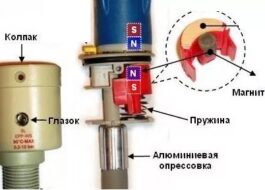

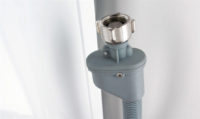














Funny. If the inlet hose breaks, will the water from the washing machine jump 80 cm up to leave the tank? No, have you ever stood next to a washing machine?